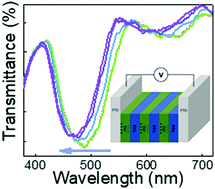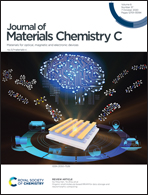Electro-responsivity in electrolyte-free and solution processed Bragg stacks†
Abstract
Achieving an active manipulation of colours has huge implications in optoelectronics, as colour engineering can be exploited in a number of applications, ranging from display to lightning. In the last decade, the synergy of the highly pure colours of 1D photonic crystals, also known as Bragg stacks, with electro-tunable materials have been proposed as an interesting route to attain such a technologically relevant effect. However, recent works rely on the use of liquid electrolytes, which can pose issues in terms of chemical and environmental stability. Here, we report on the proof-of-concept of an electrolyte free and solution-processed electro-responsive Bragg stack. We integrate an electro-responsive plasmonic metal oxide, namely indium tin oxide, in a 1D photonic crystal structure made of alternating layers of ITO and TiO2 nanoparticles. In such a device, we observed a maximum of 23 nm blue-shift upon the application of an external bias (10 V). Our data suggest that electrochromism can be attained in all-solid state systems by combining a judicious selection of the constituent materials with device architecture optimisation.



 Please wait while we load your content...
Please wait while we load your content...